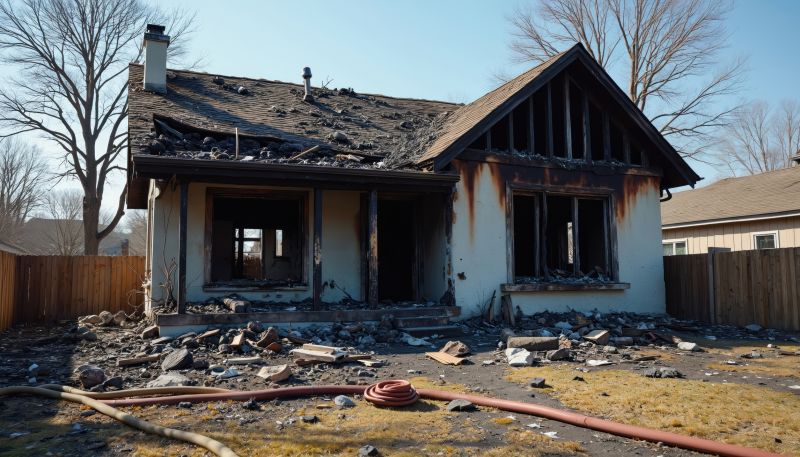Expert Picks For Fire Restoration Products That Get The Job Done
Browse professional-recommended supplies that ensure thorough fire damage cleanup and property restoration.
 Fire restoration is a complex process that requires a careful selection of specialized products to effectively address the aftermath of a fire. Restorers must focus on removing soot, smoke residues, and odors, while also repairing structural damage caused by heat and flames. The right tools and materials are essential to ensure safety and thoroughness during the restoration process. From cleaning agents to protective gear, each product plays a vital role in restoring a property to its pre-fire condition.
Fire restoration is a complex process that requires a careful selection of specialized products to effectively address the aftermath of a fire. Restorers must focus on removing soot, smoke residues, and odors, while also repairing structural damage caused by heat and flames. The right tools and materials are essential to ensure safety and thoroughness during the restoration process. From cleaning agents to protective gear, each product plays a vital role in restoring a property to its pre-fire condition.
Top Overall Option
Multi-Purpose Fire Damage Restoration Kit
A versatile kit that includes a range of cleaning agents, odor neutralizers, and protective gear designed specifically for fire damage scenarios. It provides a comprehensive solution for addressing soot, smoke, and heat-related damage, making it suitable for both professional restorers and serious DIY projects.
Types of Products For Fire Restorations
Soot and Smoke Cleaners
Specialized solutions formulated to break down and remove soot and smoke residues from various surfaces, including walls, ceilings, and furniture.
Odor Neutralizers
Products designed to eliminate persistent smoke odors, often using ozone or thermal fogging technology to penetrate porous materials.
Fire-Resistant Sealants
Sealants used to prevent further infiltration of smoke and odors into building materials and to reinforce structural integrity.
Protective Gear
Respirators, gloves, coveralls, and eye protection essential for worker safety during restoration activities.
Air Scrubbers and Filtration Systems
Equipment used to filter airborne contaminants and improve indoor air quality during and after restoration.
Thermal Foggers
Devices that disperse deodorizing fog to penetrate hidden areas and porous materials, neutralizing odors at their source.
Heat and Smoke Damage Repair Materials
Patching compounds, heat-resistant paints, and structural repair products to restore damaged surfaces and frameworks.
Cleaning Cloths and Sponges
Absorbent and scrub-friendly cloths designed for soot removal and surface cleaning.
Dehumidifiers
Equipment to reduce moisture levels, helping prevent mold growth and further structural damage after a fire.
Electrostatic Sprayers
Tools for applying disinfectants and deodorants evenly across surfaces, ensuring thorough coverage.
Structural Reinforcement Products
Materials used to stabilize and reinforce weakened frameworks caused by heat or fire exposure.
Popular Choices
Widely used for their effectiveness in breaking down soot and smoke residues on various surfaces.
Commonly employed to neutralize odors by producing ozone that reacts with odor-causing molecules.
Popular for their ability to penetrate porous materials and eliminate stubborn smoke odors.
Essential for safety, these are frequently used by professionals during restoration projects.
Trusted for improving indoor air quality during and after fire damage cleanup.
Popular for localized odor control in small or confined spaces.
Used for quick structural repairs and to reinforce weakened areas.
Frequently utilized to control moisture levels and prevent mold growth post-fire.
Commonly used for manual soot and residue removal.
Popular for disinfecting and deodorizing surfaces efficiently.
Choosing appropriate fire restoration products involves understanding the specific needs of the damaged area, including the extent of soot and smoke infiltration, as well as the type of materials affected. Proper application of these products can help minimize further damage, reduce health risks, and improve the overall efficiency of the restoration effort. It is important to use products that are designed for fire damage scenarios, as generic cleaning supplies may not provide the necessary effectiveness.
In addition to cleaning and deodorizing solutions, specialized equipment such as air scrubbers, ozone generators, and thermal foggers are often employed to eliminate persistent odors and airborne contaminants. Protective gear including respirators, gloves, and coveralls is also crucial to safeguard workers from harmful residues. When selecting products for fire restoration, consider compatibility with existing building materials, ease of use, and the manufacturer's safety guidelines to ensure a safe and successful restoration process.
Overall, a comprehensive approach that combines effective cleaning agents, odor neutralizers, protective equipment, and structural repair materials will help achieve the best possible outcome in fire damage scenarios. Proper product selection not only enhances the quality of restoration but also contributes to the safety and well-being of both the workers and future occupants of the restored property.
Key Buying Considerations
- Assess the extent of soot and smoke damage to determine the appropriate cleaning products.
- Choose products compatible with the surfaces and materials affected by fire damage.
- Prioritize safety features and protective gear to ensure worker safety during restoration.
- Consider the effectiveness of odor neutralizers, especially for porous materials like carpets and upholstery.
- Evaluate the ease of application and whether specialized equipment like foggers or sprayers are needed.
- Look for products that are designed specifically for fire damage scenarios rather than general cleaning supplies.
- Check for compatibility with existing structural repair materials and methods.
- Determine the size and capacity of equipment such as air scrubbers and dehumidifiers to match the scope of the project.
- Review safety data sheets and manufacturer instructions to ensure proper usage.
- Consider the environmental conditions of the property, including humidity and ventilation, when selecting products.
- Factor in the timeline for restoration and whether the products support efficient workflows.
- Ensure availability of replacement filters, consumables, and accessories for equipment used.
- Verify the product’s certification and compliance with safety standards relevant to fire restoration.
- Estimate the overall budget, balancing quality and cost-effectiveness of the products.
